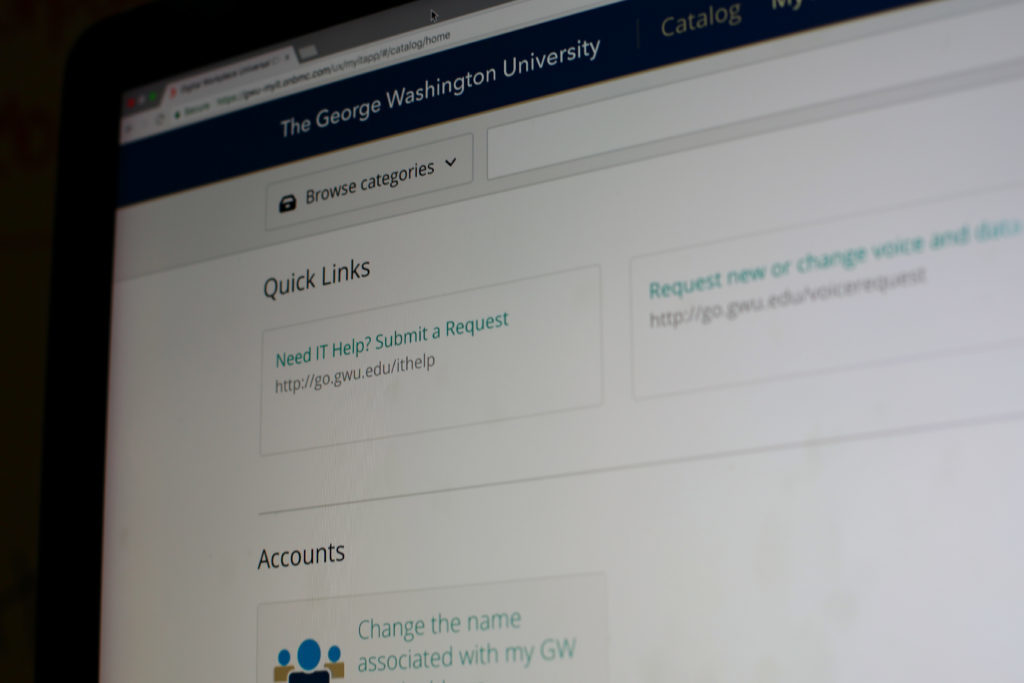Students and faculty can now manage requests for technological help in one online platform.
The Division of Information Technology announced in an email last month that students can use a new online application, Digital Workplace, to submit all requests for technology repairs, phone preferences or general IT help. Experts and student leaders said the new system will provide a more streamlined process and require less work for students trying to address technical issues.
Using the online application, billed by officials as a “one-stop-shop,” students can submit issues with University technology services including phones, email, network delays or computer-related issues. Students, faculty and staff will also be able to check the status of their requests, request mass email accounts or change settings on University phones using the new service.
“By integrating all tech requests into one platform, students won’t be bounced from tool to tool or office to office to have their tech questions answered.”
Chief Information Officer Loretta Early said the IT division started working to create Digital Workplace last fall. She said the updated program would provide more options for students to get self-service technological help and make it easier to track the progress of online requests.
“This version allows us to begin the modernization of our service request interface and integration of knowledge management into a single location,” Early said in an email. “It also puts the infrastructure in place for future enhancements.”
The in-person IT support center would continue to operate in Phillips Hall and would use the new online service to keep track of requests if needed, Early said. The University’s previous technology support center, Tech Commons, located in Gelman Library, shut down last summer – a move officials said would allow the University to offer more online support.
Before the new system was implemented, students could only contact the IT division by calling its main office number, sending an email to the department’s email address, searching through self-help resources or visiting the walk-in support center.
The new digital workplace comes after the IT division announced a new streaming network, GWplay, which allows students to wirelessly connect their Apple TV, PlayStation, Roku and Xbox devices to a new WiFi network.
James Harnett, the Student Association’s director of digital policy and innovation, said one online application like Digital Workplace, where students can submit all requests, will simplify the process of dealing with IT issues.
“By integrating all tech requests into one platform, students won’t be bounced from tool to tool or office to office to have their tech questions answered,” he said in an email.
Harnett said many students previously didn’t know who to address tech-related questions to, but now all questions can be answered using the new platform. He added that students can also use the new system for help when setting up devices on the GWplay residential network.
“As part of our ongoing work with administrators to address the transactional culture between students and the University, we will continue to support initiatives that break down silos to getting students what they need,” he said in an email.
University President Thomas LeBlanc has made improving GW’s bureaucratic staff culture a major priority in the first year of his tenure.
Allan Gyorke, the associate vice president for information technology and the chief academic technology officer at the University of Miami, said even with the new system, students will likely still prefer to submit technological issues in person rather than online because it’s easier to explain issues face-to-face.
“We actually don’t get many calls or requests through email because I think students just prefer to walk in with their devices,” he said.
“It helps to improve the student experience in making it easier and faster to get access to technical support.”
Gyorke said having an online platform could help fix issues, like WiFi problems or malfunctioning printers, which students don’t normally walk to the IT office to address.
“A student isn’t going to walk in to tell you the WiFi is down in a certain place, they’ll just kind of live with it,” he said. “You might just get a different mindset of the student reporting it immediately if they use an online platform.”
David Galassi, the assistant chief information officer for Enterprise Infrastructure and Services at the University of Southern California, described the new platform as a “terrific idea” that would make it quicker to fix any technical issues.
Galassi said students will likely still use the IT support center for hardware issues on their computers or phones, but giving students choices improves their experience working with IT.
“It helps to improve the student experience in making it easier and faster to get access to technical support,” Galassi said.





